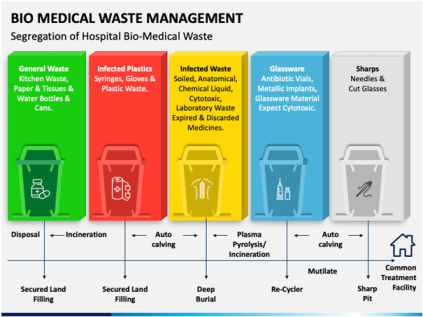Table of Contents
ToggleWASTE MANAGEMENT
Waste is any material – solid, liquid, or gas – that is unwanted and/or unvalued, and has been discarded or discharged by its owner. Waste is generated in a variety of forms, and can also change its form over time.
Healthcare Waste refers to all types of waste from all health care activities; waste generated by the health care facilities, research facilities and laboratories.
Healthcare waste is also known as biomedical waste, infectious waste or medical waste. The large volumes of health care waste if not managed properly can lead to a global hazard. This could not only lead to the spread of highly contagious diseases but the hazardous chemical waste produced by the use of items can cause considerable damage to the ecosystem and the environment.
Classification of wastes
Classification according to matter state (properties)
- Solid waste includes common household waste (including kitchen and garden waste), commercial and industrial waste, sewage sludge, construction and demolition waste, waste from agriculture and food processing, and mine and quarry tailings.
- Liquid waste includes domestic waste water (liquid kitchen, laundry, and bathroom waste), storm water, used oil, and waste from industrial processes.
- Gaseous waste comprises gasses and small particles emitted from open fires, incinerators, and vehicles, or produced by agricultural and industrial processes.
Classification of wastes- general according to their degradability
- Bio-degradable : Whether they can be degraded by physical or biological means (paper, wood, fruits and others)
- Non-biodegradable; These cannot be degraded easily by physical or biological means (plastics, bottles, old machines, cans, Styrofoam containers and others)
Classification according to their Effects on Human Health and the Environment
- Hazardous wastes: Substances unsafe to use commercially, industrially, agriculturally, or economically that are shipped, transported to or brought from the country of origin for dumping or disposal in, or in transit through, any part of the world.
- Non-hazardous: Substances safe to use commercially, industrially, agriculturally, or economically that are shipped, transported to or brought from the country of origin for dumping or disposal in, or in transit through, any part of the world.
Types of medical wastes in health care facilities
No. | Type of waste | Percentage |
1. | Non-infectious waste | 80% |
2. | Pathological waste and infectious waste | 15% |
3. | Sharps waste | 1% |
4. | Chemical or pharmaceutical waste | 3% |
5. | Pressurized cylinder, broken thermometers | Less than 1% |
Sources of health care waste
Major sources
- Hospitals
- Clinics
- Laboratories
- Research centers
- Animal Research
- Blood banks
- Nursing Homes
- Mortuaries
- Autopsy centers
Minor sources
- Dental clinics
- Physician’s office
- Home health-care
- Nursing homes
- Acupuncturists
- Psychiatric clinics
- Cosmetic piercing and tattooing
- Funeral services
- Paramedic services
- Institutions for disabled persons

Waste management hierarchy
Waste management hierarchy is defined as the order of preference for action to reduce and manage waste and is usually presented diagrammatically in the form of a pyramid.
The aim of waste hierarchy is to extract the maximum practical benefits from products and to generate a minimum amount of waste.
- Prevention/avoidance: This concept focuses on the measures to be taken so as not to create any type of wastes in the first place e.g. avoiding to eat from the ward. This is given the top priority in the waste management program.
- Reduction of Wastes/minimization: According to this concept, the health care setting should reduce or minimize the amount of waste or the toxicity of wastes e.g. avoiding to use gloves in procedures that don’t necessary need one to use gloves and companies should take action to make changes in the type of materials that are being used for the production of the specific products, so as to ensure that the by-products are of the least toxicity.
- Reuse: Reuse is another effective Solid waste management strategy, in which the waste is not allowed to enter into the disposal system. The wastes are collected in the middle of the production phase and are again fed along with the source to aid in the production process e.g. Autoclaving metal instruments or sterilization of medical equipment.
- Recycle: In the recycling strategy, the waste materials are implemented in the production of a new product. In this process, the waste materials of various forms are collected and then processed. Post processing, they enter into the production lines to give rise to new products. This process prevents pollution and saves energy.
- Energy Recovery: The energy recovery process is also called waste to energy conversion. In this process; the wastes that cannot be recycled are being converted into usable forms of energy such as heat, light and electricity etc. This helps in the saving of various natural resources. Various processes such as combustion, anaerobic digestion, landfill gas recovery, pyrolization and gasification are being implemented to carry out the conversion process.
- Treatment and Disposal: The disposal process holds the last position in the waste management hierarchy. Landfills are the common form of waste disposal.
typing . . .
please wait . . .

